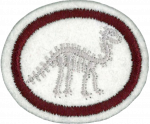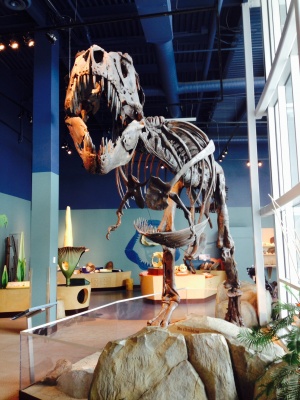AY Honors/Fossils/Answer Key/es
| Fósiles (Asociación General) | ||
|---|---|---|
| Asociación General
|
Destreza: 2 Año de introducción: 1944 |
|
Requisitos
|
La especialidad de Fósiles es un componente de la Maestría Conservación. |
| Conexión Logros para la Investidura: Esta especialidad está relacionada con los requisitos de Logros para la Investidura para EXPLORADOR Estudio de la naturaleza que requiere estudiar artículos que complementan esta especialidad. Esta especialidad es una elección popular para la especialidad de la categoría de Estudio de la naturaleza de nivel de destreza 2 o 3 requerido para los EXPLORADORES DE CAMPO Y BOSQUE. |
1
2
2a
2b
2c
2d
2e
2f
2g
2h
2i
2j
2k
2l
2m
2n
2o
2p
2q
2r
2s
2t
2u
3
Most museums of natural history will have a fossil collection, and even small museums are likely to have a few. If you do not know of such a museum in your area, the Internet is your friend. Try searching for "fossil," "museum," and the name of your locality. If you are still unsure, get a list of local museums and call them. They will be happy to tell you if they have fossils on display, and if they do not, they may be able to direct you to a museum that does. Also not all museums are called a museum. The T Rex and some other fossils shown here were photographed at Science World in Vancouver. After the visit, have your Pathfinders either write their reports or present one orally. This would be a great topic for worship during your club's opening exercises, or during a campout.
4
Removal of delicate specimens
For extracting fossils from harder rocks, a sturdy mallet and cold steel chisels may also be required. Usually one needs a range of chisels in size from small ones with a sharp edge of about 1 cm (quarter of an inch), to much larger and heavier chisels. A broad-bladed chisel is often very useful for splitting rocks along their bedding plane.
Valuable fossils
If you find an obviously valuable fossil, you should contact a professional. It is too easy to ruin a fossil by attempting to remove it yourself. Leave the extraction in the hands of an experienced collector. If you find such a fossil on public land, contact the authority responsible for the land. The fossil belongs to them, and they have the right to decide what to do with it. To find a professional, contact a museum or a local university. If they do not have one on staff, they will be able to refer you to one.
5
Evolutionists and creationists both agree that fossils are formed when a creature is quickly buried in sediment. They disagree on how long ago this happened. Evolutionists believe most fossils were made millions of years ago. Creationists believe that nearly all fossils were made during Noah's flood less than 10,000 years ago.
6
- a. Carbón
- b. Petróleo
- c. Fósiles
- d. Caliza
| From Patriarchs and Prophets, pp 107, 108 |
|---|
| Everywhere were strewn the dead bodies of men and beasts. The Lord would not permit these to remain to decompose and pollute the air, therefore He made of the earth a vast burial ground. A violent wind which was caused to blow for the purpose of drying up the waters, moved them with great force, in some instances even carrying away the tops of the mountains and heaping up trees, rocks, and earth above the bodies of the dead.
At this time immense forests were buried. These have since been changed to coal, forming the extensive coal beds that now exist, and also yielding large quantities of oil. The coal and oil frequently ignite and burn beneath the surface of the earth. Thus rocks are heated, limestone is burned, and iron ore melted. |
The Bible itself offers no explicit explanation of coal, petroleum, fossils, or limestone, though it does contain the story of Noah's flood (see Genesis chapters 6-9). In this account, the whole earth is covered by water, and all life, except those in the ark, is lost. The Biblical account of creation rejects the notion of hundred of millions of years of evolution, stating with clarity that God created the world in six days. In Genesis chapter 5, the Bible also provides genealogies of the Patriarchs, including their ages when they had children and when they died. From this, and from other historical records, the Bible sets the age of the Earth at about 6000 years.
References
There are many fine book written from a creationist perspective. Some examples:
- Before the Flood (links to book on Amazon)
- Noah's Flood-Birth of the Ice Age (links to book on Amazon)
- Rocks, Fossils and Dinosaurs (available as free digital book)
- Creation Geology: A Study Guide to Fossils, Formations, and the Flood. (links to book Amazon)
- Evidences The Records and The Flood DVD distributed by Adventist Book Centers.
- Categoría: Tiene imagen de insignia
- Adventist Youth Honors Answer Book/Honors/es
- Adventist Youth Honors Answer Book/es
- Adventist Youth Honors Answer Book/Skill Level 2/es
- Categoría: Libro de respuestas de especialidades JA/Especialidades introducidas en 1944
- Adventist Youth Honors Answer Book/General Conference/es
- Adventist Youth Honors Answer Book/Unknown/es
- Adventist Youth Honors Answer Book/Stage 0/es
- Adventist Youth Honors Answer Book/Conservation Master Award/es
- Adventist Youth Honors Answer Book/IAConnection/es
- Adventist Youth Honors Answer Book/noindex
- Adventist Youth Honors Answer Book



